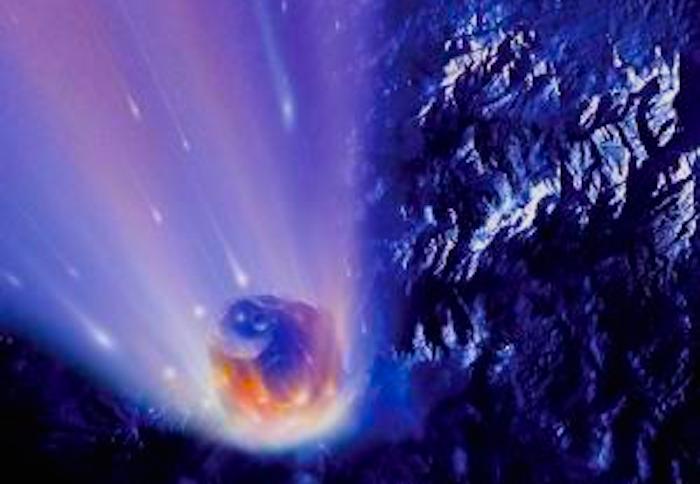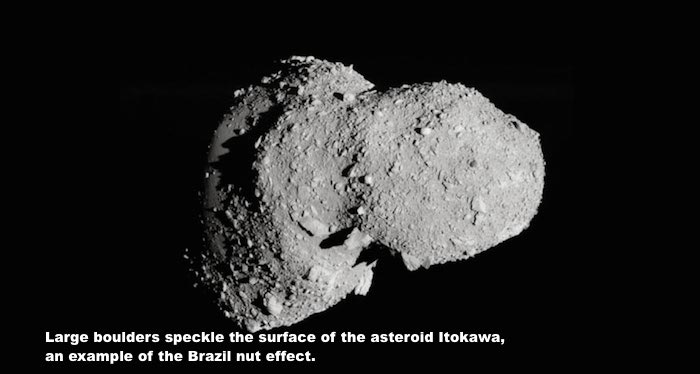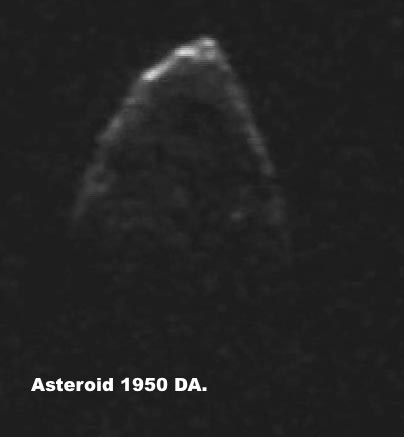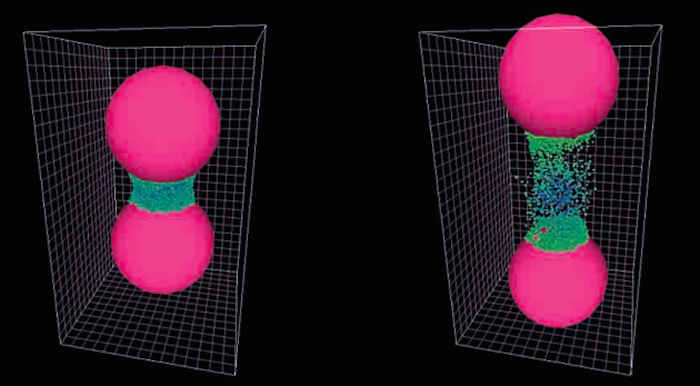.

Study of Asteroid Holds Key To Earth's Future
MOSCOW, August 15 – Scientists have discovered the forces that keep a near-Earth asteroid, 1950 DA, from breaking APART, according to a research published in Nature. The asteroid, considered by NASA a potential threat to the Earth, is a fast-rotating pile of debris that seems to be defying the forces of gravity.
Scientists say that gravity and friction are not able to prevent the asteroid from disintegrating. The debris, making a full rotation every 2.12 hours, is held together by cohesive forces known as Van Der Waals.
“We found that 1950 DA is rotating faster than the breakup limit for its density,” said Ben Rozitis, a postdoctoral researcher at the University of Tennessee, Knoxville, as quoted by the INTERNATIONAL BUSINESS Times.
The meteor that exploded over the Russian city of Chelyabinsk in February 2013 GENERATED “renewed interest in figuring out how to deal with the potential hazard of an asteroid impact,” Rozitis said. “Understanding what holds these asteroids together can inform strategies to guard against future impacts,” he added.
There are several ways to prevent an asteroid from crashing into the Earth. "The best way to mitigate an impacting asteroid is to nudge it slightly several years before impact so that it changes COURSE," he said, as quoted by Space.com. However, it might break up into “several smaller, hazardous asteroids,” the scientist warned.
"Therefore, with such an asteroid, you want to avoid interacting with it directly to prevent it breaking up. An alternative is to use a 'gravity TRACTOR,' or a heavy spacecraft placed near the asteroid, which uses the force of gravity to pull the asteroid off course," Rozitis explained.
There is a slim chance that the asteroid will hit the Earth in 2880, according to NASA’s Near Earth Object Program. However, if it does crash into the planet, the consequences could be disastrous. For instance, if the asteroid crashes into the ocean, the impact could GENERATE a tsunami at least 200 feet high, Space.com said citing a 2003 study.
Quelle: RIA NOVOSTI
.
To explain asteroid composition, scientists invoke nuts
Brazil nut effect may be behind space rocks’ lumpy surfaces

Brazil nut effect
BRUH-zil nuht ih-fekt n.
The phenomenon in which a mixture’s larger objects, such as Brazil nuts in a can of mixed nuts, rise to the top when the mix is shaken vertically. Some scientists think that smaller nuts SLIP into the spaces under the larger ones during each shake.
Now RESEARCHERS are using the Brazil nut effect to explain mysteries in space. Scientists report August 8 in the Monthly Notices of the Royal Astronomical Society that the effect could account for why only big boulders dot the surfaces of asteroids. The RESEARCHERS calculate that asteroid-quakes and impacts from smaller space rocks could jostle an asteroid enough to cause larger rocks to rise to the surface.
Quelle: ScienceNews
.
UT Research Uncovers Forces that Hold Gravity-Defying Near-Earth Asteroid Together

Researchers at UT have made a novel discovery that may potentially protect the world from FUTURE collisions with asteroids.
The team studied near-Earth asteroid 1950 DA and discovered that the body, which rotates so quickly it defies gravity, is held together by cohesive forces, called van der Waals, never before detected on an asteroid.
The findings, published in this week’s edition of the science journal Nature, have potential implications for defending our planet from a massive asteroid impact.
Previous research has shown that asteroids are loose piles of rubble held together by gravity and friction. However, the UT team found that 1950 DA is SPINNING so quickly that it defies these forces. Ben Rozitis, a postdoctoral researcher; Eric MacLennan, a doctoral candidate; and Joshua Emery, an assistant professor in the Department of Earth and Planetary Sciences, wanted to know what keeps the body from breaking APART.
Looking at thermal images and orbital drift to calculate thermal inertia and bulk density, the team detected the action of cohesive forces in an environment with little gravity.
“We found that 1950 DA is rotating faster than the breakup limit for its density,” said Rozitis. “So if just gravity were holding this rubble pile together, as is generally assumed, it would fly apart. Therefore, interparticle cohesive forces must be holding it together.”
In fact, the rotation is so fast that at its equator, 1950 DA effectively experiences negative gravity. If an astronaut were to attempt to stand on this surface, he or she would fly off into space unless he or she were somehow anchored.
The presence of cohesive forces has been predicted in small asteroids, but definitive evidence has never been seen before.
The finding provides important information for efforts aimed at stopping an asteroid from crashing into Earth.
“Following the February 2013 asteroid impact in Chelyabinsk, Russia, there is renewed interest in figuring out how to deal with the potential hazard of an asteroid impact,” said Rozitis. “Understanding what holds these asteroids together can inform strategies to guard against future impacts.”
This research reveals some potential techniques, such as a kinetic impactor which would deploy a massive object on a collision course with the asteroid, could exacerbate the impact’s effects. For example, this technique could destabilize the cohesive forces keeping the asteroid together, causing it to break apart into several threatening asteroids headed for Earth.
This may be what occurred with the asteroid P/2013 R3, which was caught by the Hubble Space Telescope in 2013 and 2014 coming undone, possibly due to a collision with a meteor.
“With such tenuous cohesive forces holding one of these asteroids together, a very small impulse may result in a complete disruption,” said Rozitis.
The researchers’ findings also have implications for space exploration. For example, the European Space Agency’s Rosetta spacecraft will land on Comet 67P/Churyumov-Gerasimenko’s surface and may find a dusty surface dominated by such cohesive forces.
Quelle: University of Tennessee
.
Near-Earth asteroid held together by weak force
Discovery suggests better ways to deflect an incoming space rock.

Cohesive forces help hold together 'rubble-pile' asteroids when forces strong enough to overwhelm gravity are applied — shown here in a COMPUTER simulation.
.
One of the most infamous near-Earth asteroids is held together by forces other than just gravity and friction. RESEARCHERS have found that asteroid (29075) 1950 DA is a loose blob of particles that clot together much as Moon dust collects on astronauts’ spacesuits.
Any mission to divert an asteroid on a collision course with Earth would need to take these newfound cohesive forces into account, suggest the findings, published in Nature1 on 14 August. This means that gently nudging an asteroid onto a new trajectory is potentially a safer option than blasting it to smithereens, Armageddon-style.
“You’d want to avoid interacting with the asteroid directly,” says Ben Rozitis, a planetary scientist at the UNIVERSITY of Tennessee in Knoxville, and a co-author of the study.
RESEARCHERS have suspected that undetected cohesive forces help to hold some asteroids together — especially ‘rubble-pile’ asteroids, which are agglomerations of dirt and rock2. Some of these rotate slowly enough for the gravitational attraction between the particles to hold them together. But for faster-spinning asteroids, centrifugal forces would overwhelm the gravitational pull and rip the rocks APART.
The fast-spinning 1950 DA will pass close by Earth in the year 2880. At one point, the odds of its hitting Earth were estimated to be as high as 1 in 300 (ref. 3), but more recent observations have lowered that risk to 1 in 4,000 (ref. 4).
Using information about how sunlight nudges the rock through space, along with measurements of its shape and the thermal properties of its surface, Rozitis and his team calculated its density. The rock turned out to be surprisingly lightweight, at just 1.7 times the density of WATER. That implied that the 1.3-kilometre-wide rock contains a lot of empty space, making it one of the rubble-pile group, Rozitis says.
If 1950 DA is a rubble-pile asteroid, then something more than gravitational attraction must be holding it together as it spins around. Calculations suggest it could SPIN no faster than about once every 2.2 hours if it were held together by gravity alone, but the asteroid goes faster than that, once every 2.1 hours. The researchers calculated that cohesive forces, exerting no more pressure than a coin resting in the palm of a hand, must be at work.
Understanding such forces could be important for NASA’s plan to drag an asteroid into lunar orbit to study it, or for commercial companies that claim they plan to mine asteroids, says Daniel Scheeres, an aerospace ENGINEER at the UNIVERSITY of Colorado Boulder.
The forces would also be important if an asteroid were discovered to be heading towards Earth. One leading strategy to deflect it is a ‘gravity tractor’, a spacecraft that would fly alongside the asteroid, using its gravitational to pull the rock onto a new trajectory. Such an approach would be preferable to blasting the asteroid APART, says Rozitis, because nobody knows exactly how the cohesion would affect how the fragments blast apart.
“I just hope that an asteroid on a collision course with Earth will not be SPINNING rapidly and it will not be a rubble-pile asteroid,” says Bong Wie, an aerospace engineer at Iowa State University in Ames.
Quelle: nature
5486 Views
